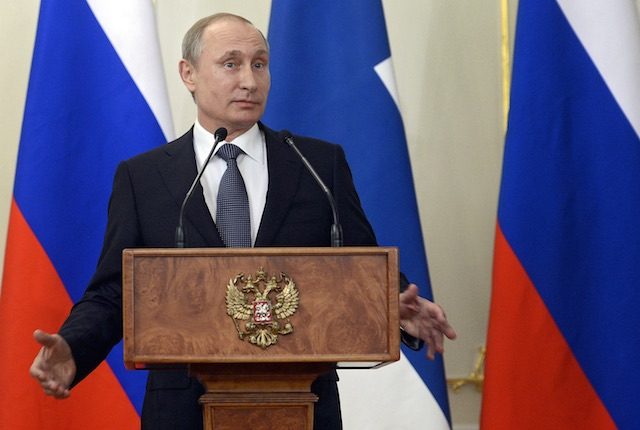SUMMARY
This is AI generated summarization, which may have errors. For context, always refer to the full article.

MOSCOW, Russia – Russian President Vladimir Putin said Tuesday, June 16, that Russia must defend itself if threatened, as the US warned against a return to a “Cold War status” after Moscow announced plans to boost its nuclear arsenal.
The declaration from the Kremlin strongman came as Russia reacted with fury to reports the US is planning to bulk up its military deployments in eastern Europe, adding to already high tensions between Russia and the West over the Ukraine conflict.
Putin said NATO – which has accused Russia of backing rebels in eastern Ukraine with weapons and its own troops, a claim Moscow denies – of “coming to our borders”.
“If someone puts some of our territories under threat, that means we will have to direct our armed forces and modern strike power at those territories, from where the threat emanates,” he said at a meeting with his Finnish counterpart Sauli Niinisto.
“As soon as some threat comes from an adjoining state, Russia must react appropriately and carry out its defense policy in such a way as to neutralize a threat against it,” Putin added.
Relations between Moscow and Western countries have plunged to their lowest point since the Cold War over conflict in Ukraine, and on Tuesday Putin once again raised the specter of the conflict by announcing plans to boost Russia’s nuclear arsenal by the end of the year.
“This year, the size of our nuclear forces will increase by over 40 new intercontinental ballistic missiles that will be able to overcome any, even the most technologically advanced, missile defense systems,” Putin said at the opening of an exhibition of military hardware outside Moscow.
‘Cold War status’
The United States slammed the announcement as a retrograde move reminiscent of the Cold War.
“We’ve had enormous cooperation from the 1990s forward with respect to the destruction of nuclear weapons that were in former territories of the Soviet Union. And nobody wants to see us step backwards,” said US Secretary of State John Kerry.
“Nobody should hear that kind of announcement from the leader of a powerful country and not be concerned about what the implications are,” he said, adding that “nobody wants to – I think – go back to a kind of Cold War status.”
Russia has an estimated 7,500 nuclear warheads, according to the Stockholm International Peace Research Institute, of which around 1,780 are deployed on missiles or at military bases.
The United States, in comparison, has some 7,300 warheads, of which 2,080 are deployed.
In 1991, the US and the then-Soviet Union signed the START treaty to reduce the size of their nuclear arsenals. Kerry in April said the US was ready to hold new negotiations with Russia on additional strategic nuclear cuts below the level agreed in the 2011 New START treaty.
NATO head Jens Stoltenberg said Putin’s remarks were part of a pattern of aggressive behavior by Moscow.
“This nuclear saber-rattling by Russia is unjustified, destabilizing and it is dangerous,” Stoltenberg said.
But Putin said that observers should not “blow anything out of proportion” with regard to Russia’s perception of the threat from NATO, saying it was “more political signals aimed towards Russia or its allies.”
Reports of US deployments
Poland and other countries in Eastern Europe have been rattled by Russia’s actions in Ukraine, where it annexed the Crimea peninsula in 2014 before pro-Moscow separatists began fighting Kiev’s forces in the country’s east.
NATO has moved to reassure Russia’s nervous Eastern European neighbors, launching US-led drills in the Baltic states and Poland earlier this month.
The New York Times reported at the weekend that the Pentagon was poised to station heavy weapons for up to 5,000 American troops in several Eastern European and Baltic countries to deter Russian aggression.
This would be the first time since the end of the Cold War that the US has had heavy military equipment – including battle tanks – in newer NATO members that were under Moscow’s influence in the Soviet era.
Poland said on Sunday, June 14, it was in talks with Washington about storing heavy US weaponry on its soil.
US Air Force Secretary Deborah Lee James said F-22 fighter jets could be deployed to Europe as the standoff with Moscow rumbles on, The Wall Street Journal reported Monday, June 15.
Russia’s foreign ministry has lashed out at the mooted US deployments in the region, warning that the move could “take on a life of its own”.
Russia’s Deputy Defence Minister Anatoly Antonov on Tuesday accused NATO of “pushing (Moscow) towards an arms race,” state-run agency RIA Novosti reported.
Putin on Tuesday toured a vast arms fair at a site outside the capital that is set to become a “Patriot Park” which will showcase Moscow’s military might.
The Russian leader, who enjoys sky-high approval ratings and has pumped vast sums into retooling Russia’s armed forces, praised the country’s military-industrial complex as a “locomotive for innovation”. – Max Delany, AFP / Rappler.com
Add a comment
How does this make you feel?
There are no comments yet. Add your comment to start the conversation.